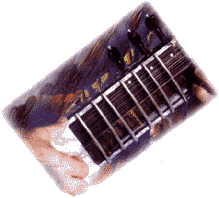The Sitar

Planet Passion by Ancient Future featuring Pandit Habib Khan (sitar).
Ancient-Future.Com AF 2010. 30th Anniversary Remastered Edition.
Digipak CD/Booklet- $17.98 (SALE $10):
Add CD to Cart. Buy CD Now. (Best Quality)
iTunes. (Download Quality)
Featured Sound File
Socha Socha (Khan/Montfort. 10:34). >YTmusic.
The instruments of Indian classical music fall into two main categories: those that carry the main melody and those that accompany. Of the many melodic instruments, the most prominent are the plucked lutes, sitar and sarod in the north and vina in the south.
The sitar is fashioned from a seasoned gourd and teakwood and typically has six or seven playing strings and 13 sympathetic strings. According to legend this elegant instrument, which has been around for 700 years, was invented by Amir Khusro, a thirteenth century poet, musician, and scholar. Perhaps more than any other musical instrument, the sitar is associated with Indian and the classical music of that country.
Over the centuries, the instrument itself has been modified, and generations of musicians have left their mark on the myriad of styles and techniques of playing it.
Tuning the Sitar
The sitar is generally tuned with the tonic close to C# or D. There are three or four strings that are played fretted, three strings that are played as drone accompaniment, and 13 strings that are tuned to all the notes in the raga to produce sympathetic vibrations.
The playing strings are tuned (from high to low) to the fourth above the tonic (known as ma), the tonic (sa), the fifth below the tonic (pa), and if there is a fourth it is tuned to the octave below the tonic (sa). Most of the fretted notes are played on the first string (ma) using only the first and second fingers of the left hand.
The drone strings are tuned (from low to high) to the fifth above the tonic (pa), the octave above the tonic (sa), and two octaves above the tonic (sa).
The sympathetic strings are tuned (from low to lower to low to high) starting with the octave above the tonic (sa), then going one note below to the seventh (ni), then repeating the octave above the tonic, then proceeding one note higher to the second above the octave above the tonic (re), then proceeding to the third (ga), the fourth (ma), the fifth (pa), the sixth (dha), the seventh (ni) and so on until one runs out of strings. Some notes are doubled to allow, for example, for ragas with two sevenths (ni).
Recommended Records Featuring Sitar
Fusion
- Planet Passion by Ancient Future (Ancient-Future.Com 2010)
- Ecstasy by Habib Khan (RPG)
- Dreamchaser by Ancient Future (Sona Gaia/MCA 154)
- Visions of a Peaceful Planet by Ancient Future (WFM AF-79)
Classical
- Colors of Sound by Habib Khan (Eternal Music)
Video Featuring Sitar
The Guitar-Sitar Jugalbandi version of Ancient Future featuring Matthew Montfort (scalloped fretboard guitar), Pandit Habib Khan (sitar) and Arshad Syed (tabla) performs Montfort's composition, "Dawn of Love." Jugalbandi is a classical North Indian musical duet (literally "tied together"), in this case with the unusual configuration of sitar and guitar accompanied by tabla. This song is now available in The Archive of Future Ancient Recordings by Ancient Future.
Additional Resources
Skype School
Further instruction on this material is available through private Skype lessons with the author, Matthew Montfort.
More About the Sitar
Pandit Habib Khan is the resident sitar master of the band Ancient Future. Additional information about the sitar can also be found through the Ancient Future World Fusion Music Links Page.


